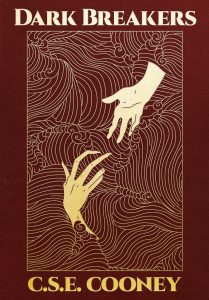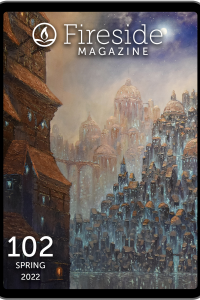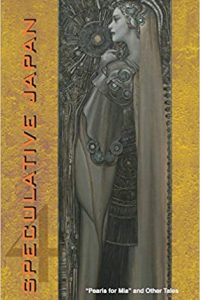Ian Mond Reviews Dark Breakers by C.S.E. Cooney
 Dark Breakers, C.S.E. Cooney (Mythic Delirium 978-1-73264-406-9, $33.95, 292pp, hc) February 2022.
Dark Breakers, C.S.E. Cooney (Mythic Delirium 978-1-73264-406-9, $33.95, 292pp, hc) February 2022.
Dark Breakers is the first of two books to be released in 2022 by the wonderful C.S.E. Cooney, who swept me away a couple of years back with her terrific short novel “The Twice Drowned Saint”. (The second book is Saint Death’s Daughter, the first in a trilogy that, based on the cover blurb, looks like it’s going to be a bit of a romp). The five stories collected in Dark Breakers occur in the same universe as Cooney’s Tordotcom novella Desdemona and the Deep. This includes heavily revised versions of “The Breaker Queen” and “The Two Paupers”, which Cooney self-published more than a decade ago, and three stories that are original to the collection, including the rather excellent novella, “Salissay’s Laundries”. As with “The Twice Drowned Saint”, the stories in Dark Breakers – which, when read together, have all the depth and complexity of a novel – demonstrate Cooney’s love for language, her inventive worldbuilding, and her remarkable skill at shaping memorable characters.
Sharon Shinn’s insightful introduction not only provides us with the origin story to the Dark Breakers universe but also offers up an eloquent description of Cooney’s central conceit:
With the Dark Breakers, Claire has created three nested worlds linked by Breaker House, where passageways open between realms at certain times in certain rooms. There’s one world for humans [Athe], one for gentry folk [Valwode], and for the goblin king and his people [Bana the Bone Kingdom]. A few inhabitants can move between domains, often at great peril, to fight for crowns or wealth or souls.
The opening novella, “The Breaker Queen”, introduces us to the characters we are about to fall in love with. There’s the Voluptuist Artist Elliot Howell, whose striking paintings catch the eye of wealthy socialite Desdemona Mannering, significantly improving Elliot’s fortunes. There’s Gideon Alderwood, Elliot’s best friend from college and Desdemona’s cousin, who, despite his wealthy family, lives a sullen, even miserable existence in a tiny garret where he obsessively sculpts and destroys the same statue. Living next door to Gideon is Analise Field, a gifted author whose breakout novel reimagines the contemporary world as if the veil between Athe, Valwode and Bana the Bone Kingdom had not been split. Her fractious relationship with Gideon is central to “The Two Paupers”, especially after she steals away one of his statues before Gideon can destroy it, only to discover that the statue is alive. And then there’s the remarkable Nyx the Nightwalker, Lady of Dark Breakers, Queen of the Valwode, who, having grown tired of ruling the gentry, has travelled to Athe looking for a diversion, only to fall in love with Elliot Howell – a decision of the heart that will have significant repercussions for all three worlds.
As I found with “The Twice Drowned Saint”, it didn’t take long for me to be hooked by Cooney’s world-building: her Gilded Age secondary world and the mythology of three nested realities – human, fairy and goblin – cleaved apart by a centuries-old war. Underpinning her world-building is how both “The Breaker Queen” and “The Two Paupers” are stories that recognise the magic – both literal and figurative – imbued in the act of artistic creation, whether it be paintings, sculptures or prose. There’s magic at a story level where art has an intoxicating influence on the gentry (“[mortal art] teaches [the gentry] how to dream of death…. The deathless dream of the Valwode! We have no defense against it”), and there’s Cooney’s magical ability at imbuing her worlds and characters with a life that goes beyond the page – a reminder that fiction is also a potent drug to us mortals.
For those who haven’t already done so, once you’ve finished “The Two Paupers”, you should read Desdemona and the Deep, which is a wonderful book made all the richer by the two novellas that precede it. Then come straight back to Dark Breakers and dive into the final three stories. In the first of these, “Salissay’s Laundries”, Cooney builds on the social issues raised in Desdemona and the Deep and explores the dark underbelly of her Gilded Age, with investigative journalist Salissay Dimaguiba going undercover to report on the forgotten people, apparently enchanted by the gentry, who enter and never leave SeaFall City Laundries. While the story is about Dimaguiba coming to terms with the fact that the gentry are, in fact, real; there’s a strong focus on how poorly Dimaguiba’s society (and by extension our own) has treated the poor and those with mental health issues. As Salissay writes: “What we must ask ourselves, as we have asked when confronted with the conditions of the other workhouses, prisons, and asylums of our fair city, is: is the cure worse than the disease?” Two lovely codas then follow the novella. There’s the tear-jerking and gorgeously written “Longergreen” that acts as the perfect capstone to “The Two Paupers” and the whimsical and funny “Susurra to the Moon”, which could easily have been the final chapter of Desdemona and the Deep.
I would be very a happy reader if Cooney decided to revisit the worlds of Dark Breakers; in the meantime, roll on Saint Death’s Daughter.
Ian Mond loves to talk about books. For eight years he co-hosted a book podcast, The Writer and the Critic, with Kirstyn McDermott. Recently he has revived his blog, The Hysterical Hamster, and is again posting mostly vulgar reviews on an eclectic range of literary and genre novels. You can also follow Ian on Twitter (@Mondyboy) or contact him at mondyboy74@gmail.com.
This review and more like it in the March 2022 issue of Locus.
 While you are here, please take a moment to support Locus with a one-time or recurring donation. We rely on reader donations to keep the magazine and site going, and would like to keep the site paywall free, but WE NEED YOUR FINANCIAL SUPPORT to continue quality coverage of the science fiction and fantasy field.
While you are here, please take a moment to support Locus with a one-time or recurring donation. We rely on reader donations to keep the magazine and site going, and would like to keep the site paywall free, but WE NEED YOUR FINANCIAL SUPPORT to continue quality coverage of the science fiction and fantasy field.
©Locus Magazine. Copyrighted material may not be republished without permission of LSFF.







